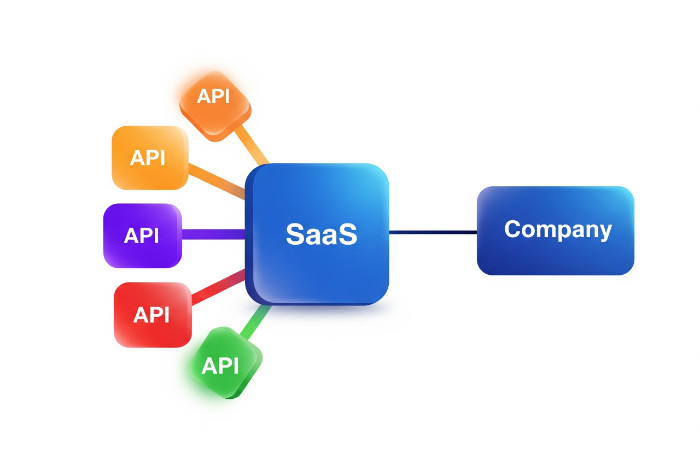How to Build SaaS Businesses with APIs in 2025
July 26, 2025

In 2025, Application Programming Interfaces (APIs) are no longer just technical connectors; they are the strategic foundation for scalable and profitable Software-as-a-Service (SaaS) businesses. The modern software ecosystem thrives on interconnectivity, and a well-designed API can unlock new market opportunities and drive exponential growth.
This shift means SaaS companies must view APIs as valuable business assets, treating them as distinct offerings that expand product reach and revenue potential.
APIs as Products: Unlocking New Business Value
The "API-as-a-Product" concept means the API itself is the core value delivered and monetized. This model involves exposing and selling an organization's unique functionality.
Strategic advantages include faster time-to-market by leveraging existing services, enhanced security as APIs act as secure proxies, and greater flexibility and reach to new customers. By offering extensible, monetizable APIs, a SaaS company builds a platform that scales exponentially, connecting its core solution to the broader software ecosystem.
Successfully adopting this requires a product-centric approach, understanding the API's purpose, and its competitive positioning.
Monetization Strategies for API-Driven SaaS
API monetization transforms APIs from technical infrastructure into direct revenue generators. Common models include usage-based pricing, where customers pay for exact consumption; freemium models, offering basic functionality for free with premium upgrades; and subscription tiers, providing fixed access for recurring fees.
Revenue sharing with partners and internal monetization for cost savings are also viable. Enabling technologies like API gateways, Identity and Access Management (IAM), analytics tools, and developer portals are crucial for implementation.
Measuring success through API integration rates, customer expansion, and revenue contribution is vital for continuous iteration and adaptation.
Emerging Trends Shaping API-Powered SaaS in 2025
The SaaS landscape in 2025 is profoundly shaped by Artificial Intelligence (AI) integration, which has become a necessity. Key trends include AI-driven and automated integration, revolutionizing workflows and data mapping. Real-time data integration and event-driven architectures enable immediate insights.
API-led connectivity and microservices simplify system connections, fostering faster innovation. The surge in cloud-native and iPaaS solutions offers scalability and flexibility. Integration for IoT, edge computing, and 5G addresses new data challenges.
Enhanced security, often AI-driven, protects multiplying integration points. Finally, the democratization of integration through low-code/no-code platforms accelerates digital transformation. APIs are becoming the foundational infrastructure allowing these advanced technologies to interact seamlessly.
Building for Success: Lifecycle and Best Practices
Overseeing an API involves a comprehensive, product-centric lifecycle. The Design stage defines requirements and the API contract, often using a "design-first" approach with developer feedback.
Implementation focuses on building and rigorously testing the API, ensuring architectural patterns like orchestration and data transformation are available. Management is the ongoing process of securing, deploying, monitoring, and troubleshooting the API.
Key best practices include robust documentation that is accurate, educational, and comprehensive, with detailed references and practical guides. Effective versioning is critical for managing changes without breaking existing integrations, emphasizing backward compatibility and clear communication.
Proactive error handling with data validation, centralized middleware, and user-friendly messages is essential for resilience. Strong security measures, including AI-driven solutions, are paramount.
Scalability must be designed in from the outset, and adherence to API design principles, such as using nouns for resources and avoiding mirroring internal database structures, ensures a stable abstraction layer. A holistic approach to API quality, focusing on developer experience, stability, and security, is vital for long-term success.
Real-World Impact
Companies like Twilio, WhatsApp, and AccuWeather exemplify the power of well-executed APIs. Twilio's success stems from its simple communication APIs, enabling seamless customer engagement.
WhatsApp Business leverages APIs for personalized "conversational commerce," linking to CRM systems. AccuWeather provides hundreds of customized APIs for detailed weather data, empowering clients to integrate real-time information.
These examples demonstrate that effective API deployment can lead to significant increases in operational efficiency and user satisfaction.
Building a successful SaaS business in 2025 means embracing APIs as core products and strategic assets. By adopting an API-first mindset, implementing robust lifecycle management, and leveraging emerging trends like AI and real-time data, SaaS companies can unlock new revenue streams, accelerate innovation, and build hyper-connected, resilient platforms that drive unparalleled growth and customer value.
For those looking to accelerate their SaaS development with a vast array of pre-built data integrations, API Ninjas provides over 100 data APIs to power your next big idea. Check out our APIs page to see what we offer.